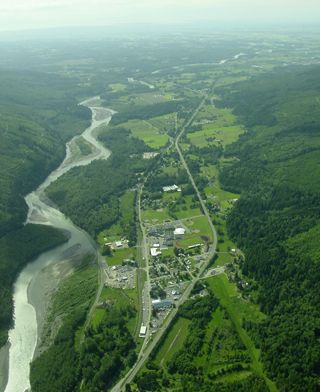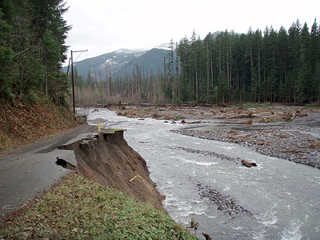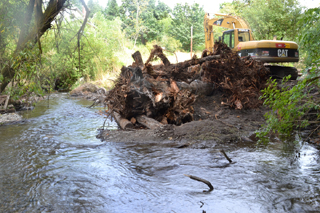|
Subscribe / Renew |
|
|
Contact Us |
|
| ► Subscribe to our Free Weekly Newsletter | |
| home | Welcome, sign in or click here to subscribe. | login |
Environment
| |
 |
September 29, 2011
Floodplain management: the Rx for flood pains
GeoEngineers

Fellows
|
In the face of climate change and a substantially increasing population in Puget Sound, floodplain management is achieving results that bode well for the future.
Levees and other river-management structures in Western Washington’s rivers seemed like ideal solutions to flooding concerns in the early to mid-1900s, but are now being recognized as only part of a broader, more holistic, strategy for floodplain management that is successfully meeting challenges related to flooding, habitat, sedimentation, erosion and infrastructure.
While many challenges remain to be overcome, a consensus appears to be emerging among the many stakeholders active in river management that comprehensive planning, stronger regulations, better engineering and strategic partnerships can achieve results and provide hope that we can live in harmony with our local river systems.
Puget Sound rivers
Population in the Puget Sound increased from about 1 million people in the 1950s to 4 million now, with a projected 5.4 million people by 2025. Historically, people often settled near rivers with little thought to flooding, habitat or water quality. Poorly designed or constructed levees provided a feeling of safety while providing little protection against large floods. Filling of wetlands and channelizing rivers destroyed habitat of all types and contributed to increased stormwater runoff and pollutant loadings.
Warming due to global climate change is causing multiple effects in Western Washington rivers:
• Retreating glaciers on Mount Rainier, Mount Baker and other peaks are exposing large areas of sediment that readily move downstream, raising river bed levels and reducing the capacity of rivers to convey peak flood flows.
• Rainfall during storm events is intensifying, increasing flood flows and elevations.
• While the lingering deep snowpacks and extended ski season this year may raise doubts, the clear long-term trend is toward reduced snow packs and more winter rain at high elevations.
Robust floodplain plans
To deal with these challenges, cities and counties are increasingly preparing robust floodplain and flood hazard management plans that provide policies, procedures and programs to reduce risks to public health and safety, minimize property damage from major flood events and channel migration, lower maintenance costs and improve habitat.
King and Pierce counties in particular have prepared robust plans supported by substantial public involvement. Comprehensive planning helps identify solutions with multiple benefits and aids in prioritizing capital projects that provide the greatest benefits in a time of reduced government budgets. One outcome of this planning is that the average homeowner’s flood insurance premium in King and Pierce counties has been reduced by $381 per year.
As one element of their plans, King and Pierce counties are implementing voluntary buy-out programs for flood-prone properties.
To provide increased flood protection, Pierce County has proposed to raise its “level of protection” guideline from the 100-year storm, which is the minimum required by Federal Emergency Management Agency, to the 200-year storm for the lower 10 miles of the Puyallup River, which encompasses heavily developed areas in Tacoma, Fife and Puyallup.
King County is focusing on earthquake risk reduction in the design of new flood management facilities.
While local governments are taking steps to better manage floodplains, federal regulations are also shifting. The National Marine Fisheries Service is using Endangered Species Act requirements for salmon to strengthen how local communities manage floodplains.
FEMA has long implemented a national flood insurance program that encourages cities and counties to regulate development in flood plains. In 2008, NMFS determined that continued implementation of the FEMA program in Puget Sound adversely affects the habitat of threatened and endangered salmon.
FEMA responded by developing a set of options that cities and counties can implement to be compliant with ESA requirements. These regulations expand the regulated area adjacent to rivers and require actions to maintain public safety and health, habitat and water quality.
Promising river restoration
Thousands of habitat restoration projects in Puget Sound lowland rivers have been completed and are already helping to restore dwindling salmon runs. Engineered log structures are increasingly being used in lieu of rock armoring to maintain river channels in desired locations and prevent bank erosion.
Setting back levees farther from existing river channels is considered one of the best long-term methods to reduce flooding and improve habitat by reconnecting flood plains and allowing for natural channel migration. New, well-engineered levees replace existing levees whose constructed quality is not well known.
With FEMA accreditation of new levees, property owners would be able to drop mandatory flood insurance policies that can cost thousands of dollars annually.
Challenges in implementing levee setback projects are acquiring land in the floodplain and moving or modifying infrastructure such as roads, bridges and utilities. Levee setbacks can be expensive, with costs of several million dollars per mile or more.
Sediment management
Sediment management is a re-emerging challenge in many Western Washington rivers.
Historically, many Western Washington rivers were dredged to build levees and maintain channel conveyance capacity. Due to permitting challenges related to salmon habitat impacts, gravel removal rates declined in the 1990s and finally ceased altogether.
Now, municipalities including Pierce, King and Whatcom counties are beginning to plan limited gravel-removal projects. The goal is to identify strategies for permitting and monitoring that might be required to obtain approvals for removing gravel bars and river sediments.
“Gravel removal may be accepted by the resource agencies, tribes and other stakeholders if it is completed as one element of broader watershed-management efforts that include expanded riparian corridors, habitat enhancement and land-use strategies that accommodate periodic inundation,” says Russ Ladley, resource protection manager for the Puyallup Tribe.
Successful partnerships
Local partnerships that bring together a wide range of participants help build consensus, speed implementation of beneficial projects and have a solid track record in achieving results.
The Nooksack Recovery Team partnership, comprised of local municipalities, tribes, timber companies and other stakeholders, has completed more than 600 recovery actions to protect and restore watershed habitat and improve fish passage. These projects have gained broad community support through public involvement and the successful completion of past projects.
Mark Isaacson, director of King County’s Water and Lands Division, acknowledged the importance of partnerships.
“Regional partnerships are a very important element of King County’s floodplain management project implementation strategy,” Isaacson said. “It takes time to build consensus among stakeholders, but it does work. On the Chinook Bend Habitat Restoration project, our partnerships with the neighboring landowners, the city of Carnation, Ducks Unlimited and others were critical to completing the final stage of this project after nearly 12 years of work. The project benefits people and salmon, and reduces county facility maintenance costs by improving habitat and water quality and allowing for natural river processes and flood storage.”
Ken Fellows, PE, is a principal engineer in GeoEngineers’ Tacoma office focusing on setback levee, habitat restoration and gravel-management projects.
Other Stories:
- Sixth Place Apartments are first in energy efficiency
- Putting a price on environmental damage
- Tacoma revitalizes itself, from the ground down
- It’s not all waste — fueling our future energy needs
- Our changing climate can be a job generator
- Indoor air problems may be coming from below
- Urban areas scale up for EcoDistricts
- Getting to net zero with SIP panels
- Everett clinic takes a shine to LEED silver





